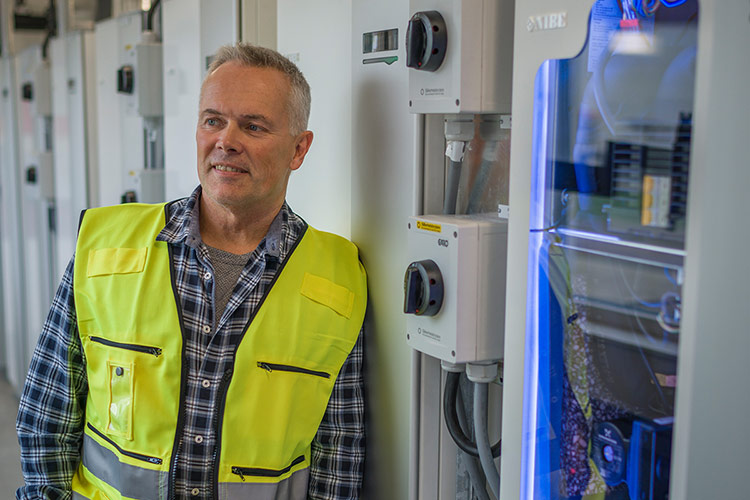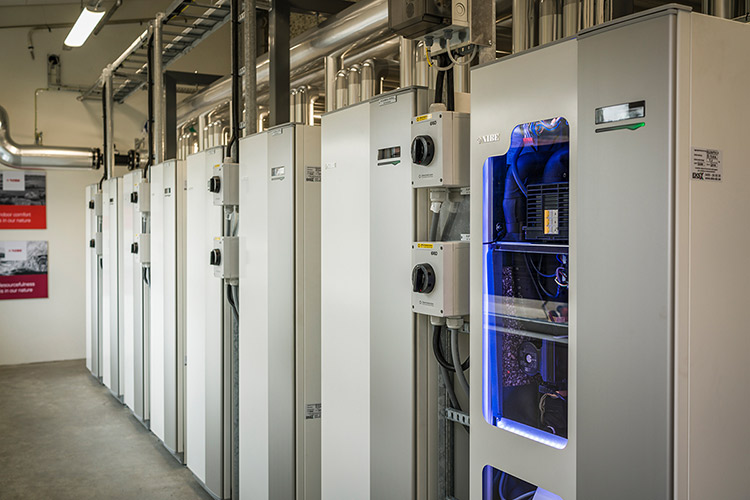One-of-a-kind heat pump efficiency at Xylem

Since its establishment as a blacksmith in Emmaboda in 1901, Xylem, formerly Flygt, has grown into a global group. But the company not only excels with regards to pumps for meeting the world’s water needs. They are also world-leaders in energy efficiency and have recently expanded the power of their already highly-efficient ground-source heat pump facility. All thanks to NIBE’s work horse NIBE F1345-60. Or rather, eight of them!
It’s just as well to get right down to it. The industrial company Xylem is incredibly energy efficient. The key ratio for purchased energy for industrial heating is 250 kilowatt hours per year and square metre. This should be compared to Xylem’s current 35 kWh/sqm with a goal of reaching 10 kWh/sqm! Did you get that? From the industry key ratio of 250 to 10 kWh/sqm! If, like Xylem, you have 110,000 square metres of space, the savings will be considerable... which is the understatement of the day.
Behind Xylem’s journey to revolutionary energy savings you will find a fleet of highly efficient heat pumps, a unique holistic mindset and a person with a passion for energy efficiency. ”In the last twenty years, we have chased improvements in energy efficiency, and in the last ten years, heat pumps have had a central role in our success. With 3,000 kW of installed heat output, we have achieved great energy savings. With the latest investment in eight new NIBE pumps we are taking the next big step toward 10 kWh of energy purchased per square metre,” says Leif Rydell who has spent the last 20 years working with saving energy at Xylem in Emmaboda.
An unparalleled holistic view
Xylem’s Emmaboda facility is like a city within a city. A 110,000 square metre stretch of factories, offices, canteens, sport halls, data centres and, the crown jewel, the foundry where the pump parts are created. It is only natural that a great deal of energy goes to heating and cooling the facility. And it is this in particular that attracts visitors and researchers from the entire world, who admiringly learn of Xylem’s energy efficiency solution.
”We have connected all buildings to an internal district heating network which we have paired with heat pumps and a powerful borehole repository to enable storage of energy when necessary. This has allowed us to heat and cool premises when we need to, and, not least, to cool our processes with the help of the heat pumps. This is how we save 35,000 cubic metres of fresh water per year. Water that is no longer needed for the cooling process. Just think! I take pride in knowing we are no longer using 35,000 cubic metres of a commodity to cool our processes,” says Leif.

A loop of cold and heat
One of the secrets behind this energy efficiency is that they have connected their buildings/processes to one another, giving Xylem the flexibility to retrieve and deliver energy between company buildings. Simply, an internal district heating network that only draws upon Emmaboda’s district heating network when necessary.
”Considering that our casting furnaces produce a lot of heat, the challenges were to harness residual heat and to cool the facility and pools. We have thirteen processes that we cool with the aid of the heat pumps. With this investment, we have also lowered the summer season temperature from 35 degrees to a more pleasant 25 degrees. At the same time, we use residual heat for heating other premises or store it in our borehole repository, which is like an accumulator,” Leif tells us.
Their own district heating network in other words supplies the operations and distributes heat and cooling depending on the overall needs. And to achieve true sustainability, in 2010 Xylem invested in a gigantic ’battery’ to enable energy storage. Not two holes in the wall, but 140 holes in the ground.
The biggest borehole repository in Sweden?
Quite possibly...and most likely one of the largest in Europe. With its 140 holes, drilled closely together over a surface of 60 x 40 metres, Xylem has created a 300,000 cubic metre ’battery’. Geoenergy expert Olof Andersson from Geostrata has been an important player during the project planning phase. ”The point of the accumulator is, of course, to enable energy storage that we can draw upon when necessary.
By injecting residual heat from our processes in the summer, we can significantly raise the temperature in the borehole and extract it when we need it in the winter. We reach a temperature of about 45 degrees in our borehole repository, which is insulated with foamed glass. With the latest investment of installing heat pumps to the repository, we hope to get a full return on our investment,” says Leif.
Energy efficiency investments continue
With the latest investment in ground-source heat pumps from NIBE Energy Systems, that is, eight NIBE F1345-60 800 kW ground-source heat pumps, Xylem is quickly reaching their dream goal. That is, to buy no more than an amazingly low 10 kWh per square metre of surface space and, as such, only have to consume one million kilowatt hours of external district heating annually. ”Once we have achieved this level, we will be considerably more efficient than modern ’passive houses’. And in all our talk of saving energy, let’s not forget that we also created a much better working environment with a more even and comfortable temperature, not to mention process stability,” says Leif.
Having now delivered a total of 14 heat pumps to Xylem, NIBE Energy Systems is impressed with how far the Emmaboda company has come. ”It is amazing that a heavy industry can have the same energy consumption as a passive house! Just by moving energy, the heat pumps become the real environmental heroes. At Xylem, energy/heating/cooling are moved from somewhere they are not useful to a place where they are. For example, the heat pumps cool conference and server rooms and the heat from these rooms is used for heating water in the sports hall or the heating system. Amazingly good energy efficiency,” says Fredrik Snygg, salesperson at NIBE Energy Systems.
The next investment sets its sights on the sun
Their ambitions don’t stop here and now. When the climate needs saving, you cannot contribute to a better environment by doing nothing. Leif believes that the technology for achieving energy efficiency already exists, but that it has to be made known across the world. ”Considering where the greenhouse effect is heading, we need to use the technology and be innovative.
Sweden has come a long way in this development and can act as a role model for others, such as developing countries. We are proud to be an example internationally. Our next step is to invest in solar energy. With over 100,000 square metres of roof space, we are talking about quite a few solar panels,” Leif Rydell concludes with a laugh.
